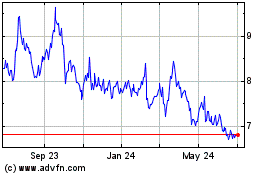GM, Honda to Develop Fuel Cell Vehicles - Analyst Blog
July 15 2013 - 2:00PM
Zacks
The leaders in hydrogen fuel cell technology, General
Motors Company (GM) and Honda Motor Co.
(HMC), entered a long-term agreement to collaborate on development
of next-generation fuel cell vehicles in order to meet the fuel
economy standard set in the U.S.
Both GM and Honda have more than 1,200 fuel cell patents between
them, filed between 2002 and 2012, and experimental vehicle fleets.
They are the top two companies in terms of total fuel cell patents
according to the Clean Energy Patent Growth Index.
Both companies aim to develop the vehicles by 2020. The alliance
will bring down their costs in building this expensive technology
by sharing each other’s expertise and suppliers.
Why Fuel Cell Vehicles?
The U.S. mandate requires corporate average fuel economy of 54.5
miles per gallon by 2020 and there is no better competent than fuel
cell vehicles. Why? Fuel cells have highly fuel-efficient
technology compared to gasoline and electric batteries. Secondly,
it has a longer driving range (up to 400 miles) than electric cars
but pollutes less than gasoline vehicles.
Fuel cell vehicles use a chemical reaction between hydrogen and
oxygen to generate power in an electric motor. They are not
pollutants because they emit water vapor and heat instead of smoke,
and the water vapor can run five times longer than electric
cars.
Fuel cell vehicles reduce dependency on petroleum. They can also be
recharged in as little as three minutes compared with eight hours
of recharging an electric battery.
Available Fuel Cell Vehicles
So far, there are only two fuel cell vehicle models available –
Honda FCX Clarity and the Mercedes-Benz F-Cell. Among them, FCX
Clarity achieved the World Green Car title in 2009. Honda plans to
launch the revamped version of FCX Clarity in Japan and the U.S. in
2015, and later in Europe.
Some of the global automakers are also trying to develop fuel-cell
vehicles through collaborations. In Jan, Toyota Motor
Corp. (TM) and BMW AG announced plans to launch fuel-cell
vehicles by the end of this decade. Daimler AG
(DDAIF), Ford Motor Co. (F) and Nissan
Motor Co. (NSANY) have also announced a tie-up to build
fuel-cell vehicles within five years.
Headwinds
Despite several advantages, the road to adoption of fuel cell
vehicles looks patchy. The major barrier to production of fuel cell
vehicles is its cost, mainly associated with the platinum required
to start the chemical reaction within the fuel cell.
Secondly, lack of hydrogen stations in the U.S. is a concern. These
stations are also concentrated in a few locations in the U.S. and
need huge investment to build (more than $1 million).
Therefore, collaborations in fuel-cell technology look sensible as
they seem to address the cost issue, whether for building the
technology itself or the network of hydrogen stations.
Currently, General Motors retain a Zacks Rank #3 (Hold).
DAIMLER AG (DDAIF): Get Free Report
FORD MOTOR CO (F): Free Stock Analysis Report
GENERAL MOTORS (GM): Free Stock Analysis Report
HONDA MOTOR (HMC): Free Stock Analysis Report
NISSAN ADR (NSANY): Get Free Report
TOYOTA MOTOR CP (TM): Free Stock Analysis Report
To read this article on Zacks.com click here.
Nissan Motor (PK) (USOTC:NSANY)
Historical Stock Chart
From Jun 2024 to Jul 2024

Nissan Motor (PK) (USOTC:NSANY)
Historical Stock Chart
From Jul 2023 to Jul 2024
